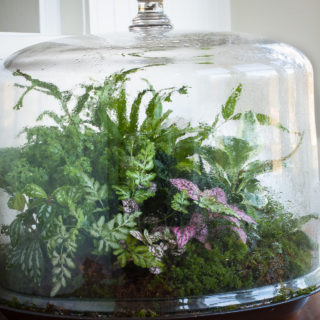Terrariums

Recipe By: Sheila McDuffie
Ingredients
- Generally speaking you want to pick plants that can tolerate humidity, since the enclosed nature of a terrarium traps in moisture. Also keep in mind that terrarium plants need to be able to tolerate low or indirect light.
- Choose plants that are small enough for your terrarium. You don’t want the plants' leaves to touch the sides of the container.
- Succulents and cacti can grow in a terrarium, but it’s best to use an open container that will retain less humidity. You should also add some sand to the potting mix to mimic the plants’ native environment.
- -- Container
- -- Activated charcoal pieces
- -- Potting soil
- -- Gloves
- -- Terrarium plants
- -- Sheet moss
- -- Watering can
- -- Trowel
- See top plants for terrariums
- There are many great choices for terrarium plants, but here are some favorites:
- Moss: Mosses are a common terrarium staple as they’re easy to find and easy to grow. Scottish and Irish moss are two popular, hardy choices.
- Baby’s Tears: Also called Angel’s Tears, this plant is made up of tiny leaves that look great in a small scale. It grows abundantly which can be a problem in an outdoor garden, but it does well contained in a terrarium.
- African Violet: This desirable, purple-blossomed plant can be difficult to grow in an open pot. They require a humid, warm environment. A terrarium makes it easy to provide both. Plant first in potting soil, then enclose the plant in a closed glass container.
- Creeping Fig: A dwarf variety of this tree-like plant can look like a tiny forest inside your terrarium. Creeping figs will tolerate some shade and/or indirect light. They grow quickly, but can be pruned back with ease.
- Excited to start your own terrarium? Check out these resources for supplies:
Instructions
- Install approximately 1-2 inches of charcoal at base of container.
- Combine remaining charcoal with soil either by hand or with trowel.
- Fill your container one-fourth to one-third full with the charcoal-and-soil mixture. Gently pack the soil every 2 inches to avoid large air pockets.
- Carefully remove your plants from their containers and position them on top of the soil to ensure proper spacing. Allow enough room between the plants for additional soil.
- Use your hands to pack soil in and around plants. Tuck plants deep enough into the soil to cover all plant roots and to keep the plants from reaching too far above the top of the container.
- With gloves, position moss on top of the soil and between the plants.
- Water plants and place container in a well-lit area with indirect light. Future watering is dependent on the types of plants you have selected and the environment they're growing in. Test the soil for moisture before pulling out the watering can.
- Maintenance is minimal once the plants are established. As they grow you may want to trim any branches that grow out and over the top of your container.
Recipe by The Gardener Cook at https://www.thegardenercook.com/terrariums/